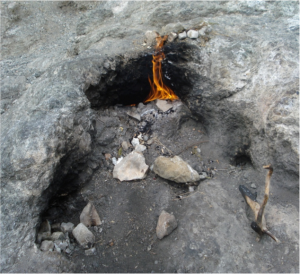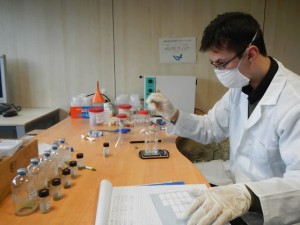15 December 2015
Cold reaction has hot implications for evolution of life
Posted by lhwang
by Amy McDermott
When carbon dioxide and hydrogen gas mingle deep underground, they transform into methane and water—the building blocks of life.
Scientists once thought the reaction, called Sabatier synthesis, could only proceed above 150 degrees Celsius. Life, they thought, was conceived deep in the scalding vents of an ancient ocean. But the Sabatier process also runs cooler, finds a new study presented at the 2015 American Geophysical Union Fall Meeting. With the right catalyst, the reaction works at room temperature, the study found.
That means “life didn’t necessarily evolve in hot soupy seas at mid-ocean ridges,” said Giuseppe Etiope, a senior geologist at the National Institute of Geophysics and Volcanology (INGV) in Rome and lead author of the study. “It also could have evolved in continents—in the rocks.”
And if life can evolve under these widespread conditions, it might have popped up quite frequently, Etiope adds, both here and elsewhere in the universe.
Our planet forges life from hydrogen and carbon. They’re welded deep in the ocean’s abyss, where molten rock called periodite flows up from the mantle and reacts with seawater, releasing hydrogen gas, said Mathilde Cannat, a marine geoscientist at the Paris Institute of Earth Physics, who was not involved in the study. At high temperatures, such as those in hydrothermal vents, the gas reacts with carbon dioxide and metals like iron, nickel, and chromium, to form methane: carbon studded with four hydrogen atoms, Etiope added.
“Hydrogen and methane are like brothers in the production of microbes,” Etiope explained. Both molecules love to donate electrons, which bacteria greedily rip away. Scientists think the earliest metabolisms hinged on hydrogen gas, and that methane was one of the first organic compounds key to the origin of life.
But that life didn’t necessarily begin in the deep sea, Etiope said. Continents also contain peridotite, but they’re not as hot as vents. Iron, nickel, and chromium won’t drive Sabatier below 100 degrees Celsius, but the scientists thought another metal might.
To test their hypothesis, Etiope and Artur Ionescu, an environmental scientist at Babes-Bolyai University in Romania, incubated carbon dioxide, hydrogen gas, and ruthenium (a metal found deep in continental crust) in small glass bottles at atmospheric pressure. They heated the bottles to 25, 50, and 90 degrees Celsius, respectively, then measured methane concentration over time.
The experiment worked: ruthenium catalyzed the Sabatier reaction, Etiope said. Methane gas spiked to a maximum of 65,000 parts per million (ppm) after 30 days at 90 degrees. It peaked at 220 ppm after 122 days at room temperature—still enough to spark life, Etiope said.
Ruthenium rocks are also common worldwide, from Spain to New Zealand, Italy to California, the researchers said. Methane can be a byproduct of decomposition and other microbial activity, but the researchers have found pockets of abiotic methane in many countries, including Spain. The next step is to confirm the Sabatier reaction is producing it, Etiope added.
If it is, the discovery has big implications for Mars, Etiope said. Scientists have found trace amounts of methane in the red planet’s atmosphere, but without volcanic or microbial activity, it’s hard to know how the gas got there. Mars does have ruthenium, so Sabatier could be the answer.
‑Amy McDermott is a graduate student in the Science Communication program at UC Santa Cruz. You can follow her on twitter at @amygmcdermott.




 GeoSpace is a blog on Earth and space science, managed by AGU’s Public Information staff. The blog features posts by AGU writers and guest contributors on all sorts of relevant science topics, but with a focus on new research and geo and space sciences-related stories that are currently in the news.
GeoSpace is a blog on Earth and space science, managed by AGU’s Public Information staff. The blog features posts by AGU writers and guest contributors on all sorts of relevant science topics, but with a focus on new research and geo and space sciences-related stories that are currently in the news.